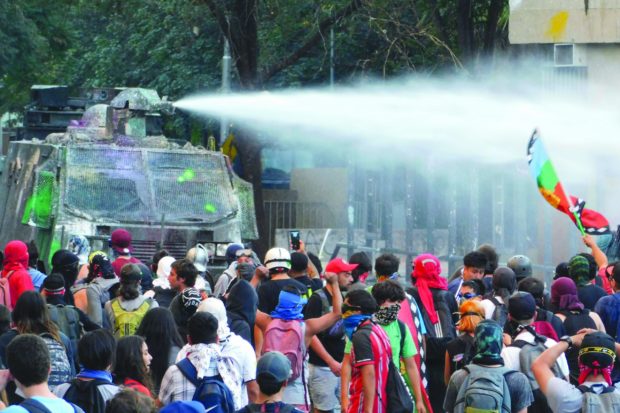
By Juan Trujillo Limones
SANTIAGO, CHILE—“I’m going for my mother, for a better and dignified retirement,” 33-year-old Mauricio Fredes Lambi told his family when he left home to participate on the front line of the protest in Plaza Baquedano, renamed Plaza de la Dignidad, in the center of the Chilean capital. A little more than a month has passed since the tragic night in which Lambi lost his life by falling into a pit 1.8 meters deep that contained high-voltage cables and water.
After a visit in January by the Canadian Human Rights Observation Mission, it again became clear that the government has not dealt with the serious crisis of human rights violations and has not made changes in the police structure. The recommendations of Amnesty International, the United Nations and Human Rights Watch were taken into consideration for a government facing a deep social crisis.
Lambi was a painter and plasterer in the construction industry and lived in the popular neighborhood of La Pintana with his grandmother Sara, 75, whom he considered his mother. In that area, childhood friends began to participate in the social revolt in October. With them, Lambi went intermittently on Fridays to the front line, which allows the rest of the movement to demonstrate peacefully.
The case of Lambi is a powerful example of the counter-emergency strategy that has been reinforced in the country since the first week of November. Heading into the fourth month of protests, the government and the police are trying to violently stop any meetings or political activity critical of the prevailing social system, yet the insurrectionary cycle continues.
Where the front line of young people gather every Friday in the Plaza de la Dignidad, violent clashes occur as the police special forces used water cannons and teargas on the crowd. On Dec. 27, the youth rebellion expanded after the Christmas holiday due to the “zero tolerance” policy imposed by the mayor of the city, Felipe Guevara, and the growing cases of protesters’ loss of eyes from the direct shots of tear pills by the police.
Between streets, Irene Morales and Bernardo O’Higgins were on the front line confronting the police as they continued to spray water on everything that moved, even the small fires where young people were trying to dry their clothes.
As night fell, Lambi was hooded and within an area of resistance where men and women alternated positions with shields, stones and laser beams to face the police. In one corner, paramedics treated injured heads and legs. A few meters away, four women with their faces covered offered “free lentils” in a grocery cart.
At the center of the square, dances and music fed insubordination energy. The police reapplied the clamp to lock the front line and dissolve the protest. As the operation was deployed, the young people ran to leave the streets.
Lambi followed the stampede but fell into a tragic hole that had a lot of water. “As cables were running through the pit, he was electrocuted and that prevented him from leaving,” explains Luis Cordero, uncle of Lambi. Days later, the Legal Medical Service confirmed the death due to “suffocation asphyxiation.”
One month after the fact, however, it is not clear if that water was there normally or if it had accumulated from the repressive action of the water-spraying cars. “Such pits should be covered by a concrete lid,” said Cordero. “An electrical underground pit shouldn’t have water; it is suspicious. The mayor blames the protesters who—he claims— destroyed the lid to make stones to throw them at the police.”
Frontline protesters have honored their dead since that morning. The transfer of Lambi’s body to La Pintana was like a funeral walk for a hero of the homeland, and the funeral was an honor party with hype, dishes, songs and food. Supportive people helped pay for the funeral expenses.
Today, the family is recovering from the loss and a criminal complaint is on the way. The trial for the demarcation of responsibilities would undoubtedly fall on the electric power company; the chief of carabineros, Alejandro Rosas; the mayor, Guevara; and the central government of right-wing Sebastián Piñera. The government, with a 6% approval rating, continues to hold to its position.
“If the president doesn’t want to support the people, then he should resign and be replaced by a competent leader,” concluded Cordero.
With the case of Lambi and the death of Jorge Mora, a fan of the Colo Colo football team, on Jan. 29, hit by a police officer, Carlos Martínez, the serious human rights situation worsens and degrades not only the legitimacy of the police institution but also opens further the cracks in the Chilean political system that is held together with pins.
The Chilean popular insubordination will not take its feet off the streets prior to the plebiscite next April in which it will be decided whether to convene a constituent body that draws up a new Constitution.
*****
Juan Trujillo Limones is an anthropologist and a freelance journalist. Contact him at janantik7@gmail.com
